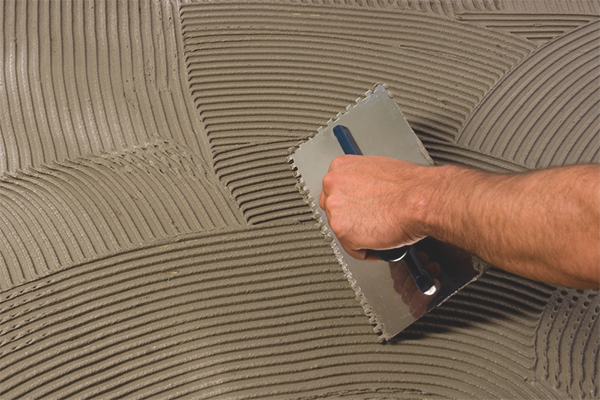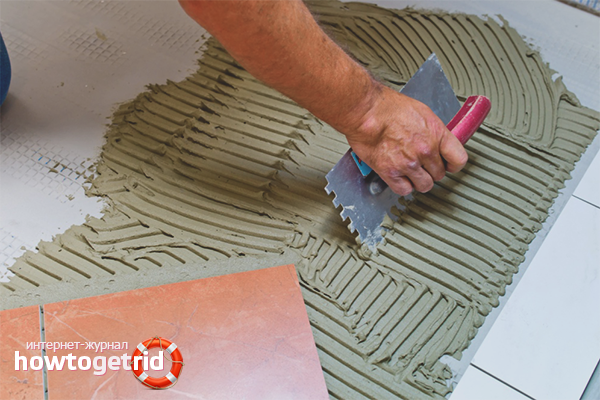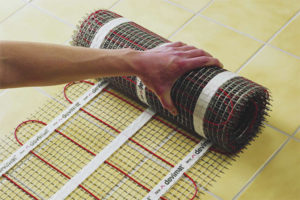The content of the article
In the building stores sell liquid glue for ceramic tiles. Single-component paste is plastic and does not dry out for a long time, it is intended for concrete and brick foundations. The minus of the invention is a small shelf life. An open package of liquid glue should be used for a month, otherwise it hardens and loses its adhesive properties. Experienced builders prepare solutions for laying tiles from dry mixes that are stored for months and are cheaper than liquid bases.
Choosing the right material
Before buying glue you need to decide on the size of the facing material. Standard tiles are laid using universal formulations or variants intended for interior decorating. This adhesive is plastic, contains a minimum of additives and is designed for concrete or brick walls.
Options for the bathroom should have moisture resistance. In such a tile adhesive add hydrophobic modifiers. If you have to work with large and heavy cladding material or non-standard walls, it is recommended to choose compositions with high adhesion rates.
Tile floor adhesive is too liquid. It spreads and slowly hardens due to the large amount of plasticizers. This option is not intended for walls.
Preparatory work
A bucket or other container in which the glue will be kneaded is carefully washed. It is impossible that particles of dried cement mortar, lime or primer remain on the walls. Any extraneous additives reduce the adhesive properties of the paste for laying ceramic tiles.
The electric drill or the construction mixer is cleaned of dirt and plaque. You can use a clean wooden stick or spatula, break the lumps with your hands.
Do not stir the solution with bare hands. It is necessary to wear rubber gloves, because some brands include aggressive chemical components that cause allergies and irritation.
Particles of dry powder can settle on the mucous membrane of the nose, eyes or bronchi. To prepare the tile solution you need in a respirator or a wet gauze dressing. It is advisable to wear construction glasses. Of course, it is impossible to poison with building compounds, but they can cause irritation and inflammation of the mucous membranes, provoke conjunctivitis and cough.
Little tricks
Tile glue is diluted not just pure, but filtered or distilled water. There are too many impurities in the tap fluid. Iron, chlorine and other minerals react with dry powder.As a result, the finished paste loses its adhesive properties or hardens too quickly.
Each manufacturer specifies different proportions. The amount of water and powder depends on the composition of the adhesive. The standard ratio is 1 to 4. Approximately 20 kg of dry billet are taken for 5 l of liquid. Sometimes the fourth part of the glue is replaced with cement, so that the composition becomes thicker and better set, and the tile keeps up with the concrete or brick foundation for years.
Phased cooking
In a container designed for mixing pasta, pour 3-4 liters of water. If you pour some powder into a bucket or bath and then add liquid, it will be very difficult to separate the dry component from the walls.
Water is stirred with a wooden stick or spatula and glue is injected in a thin stream. When the mass becomes thick, they knead it with hands, like dough. Fingers break lumps. Prepare a small plastic portion. Water and powder are then alternately added to it, until the components have run out.
It is more convenient to knead the glue with a mixer or electric drill. The nozzle is completely immersed in the mass. If part of it remains on the surface, air bubbles will enter the paste.Oxygen interacts with the mass, reducing the adhesive properties of the workpiece.
Builders who decide to stir the glue with a spatula or other tool are advised to ask for help from a friend or family member. While one person vigorously works with a wooden stick, the second sprinkles powder or adds water. In this case, you get the correct composition with a minimum amount of lumps.
Plastic and thick mass set aside for 20-30 minutes. Even in a paste made with a construction mixer, lumps remain. For half an hour they become saturated with water, swell and dissolve, and the workpiece will be homogeneous.
Proper consistency
Ceramic tile adhesive should not be too thin or thick. Both in the first and in the second case, the facing material is poorly attached to the wall. Some areas may disappear on the second day after the repair.
To understand that the mortar has a good consistency. The mass should be scooped up with a spatula, and then turned around 180 degrees. If the workpiece drains from the blade, add a little powder. The correct glue slowly slides down like a thick molasses.If the paste resembles a brick, which fell from a spatula and did not even flatten out, water is added to it.
Tips
- Tile glue quickly hardens, so it is prepared in small portions. So much powder is mixed at once to last for 1 square meter. m. walls or floors.
- The finished paste cannot be stored for longer than 4 hours, otherwise it will lose its adhesive properties.
- The powder is added to the water gradually. If you pour out the entire bag at once, you will get a stuck layer that cannot even be broken by a construction mixer.
- The present solution is whipped with an electric drill or a spatula before use to break up the remaining lumps.
- The room where the repair takes place should be no lower than 10 and no higher than 25 degrees. Frost and heat reduces the adhesion properties of the solution; it does not set well.
- A mixture coated with a film can not be used. Old glue is thrown away and a portion of new is prepared.
- Glazed tile absorbs a lot of moisture. More water than usual is added to a solution intended for such a veneer.
- Glue, which begins to harden immediately after application to the wall or tile, is thrown away. The solution has expired.Perhaps there are extra components in the composition. Save the glue will not succeed, will have to buy a new one.
- Experts recommend mixtures that allow you to adjust individual fragments within 15–20 minutes after application.
- It is better to buy a proven brand of glue. When selecting a blank, pay attention to the condition of the package and the date of production. Do not spend money on material in crumpled packages with an expiring date.
Even beginners, who have never held a construction mixer in their hands, will be able to prepare tiled glue. The main thing is to comply with the dosage, use only high-quality components and mix the solution thoroughly so that no lumps remain in it.
Video: Hand Tile Glueing












To send